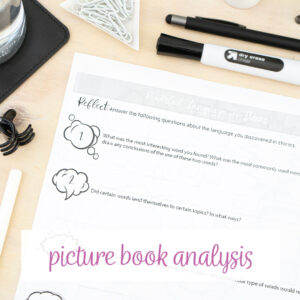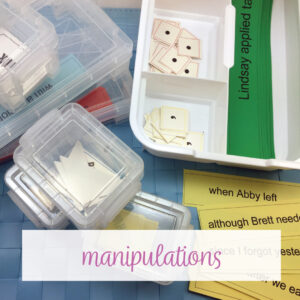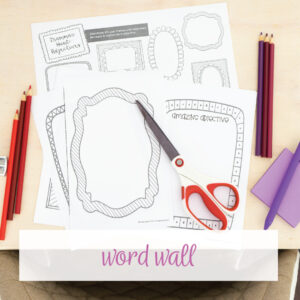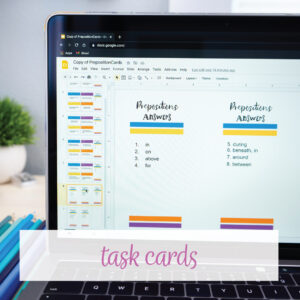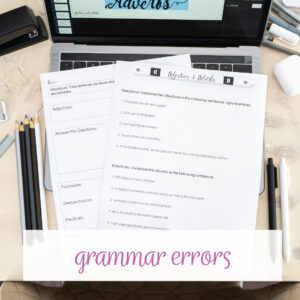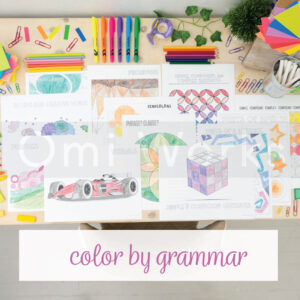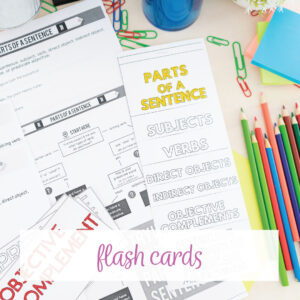Grammar stations are perfect for secondary students. You can rotate and address confusion and successes, and your students get to move and learn from others. If you’re looking for middle school English grammar activities, try stations.
Younger students use stations as a normal part of their school day. Older students enjoy them too! I utilize stations in many capacities, but I overwhelmingly move my students through grammar stations. My hope for this blog post is to outline ways you can be successful for designing grammar stations.
So many teachers ask me about ELA grammar and making it meaningful. When I treat ELA grammar like I do other parts of class, I find success. Just as I would make literature or writing stations, I use grammar stations. I’ve successfully used stations with high school students, but I often used learning stations for middle school ELA.
What works with language arts station work? Honestly, most projects and activities will work as station work as long as you provide structure. You don’t need a fancy download or complex directions for making station work suitable for your students. Plan ahead. Generally, my station work:
- Has six to seven stations. I don’t plan on every student hitting every station. The more complex stations? I have groups that simply won’t move to them.
- Spreads around the room and hall. I generally ask my coworkers if they mind if students are in the hall. Normally, no one cares. Exceptions might include test days or guest speakers where hall movement should be minimized.
- Works based on time. I tell students they have 6 minutes (I adjust if necessary) for each station, and I time them.
- Has a student answer sheet made up of a Google Document that they can share with me. If students do hands-on manipulation pieces, they take a picture and insert it in the document.
Basically, don’t complicate grammar stations. These should be fun and should allow students to experiment with their language.
Middle school English grammar lessons can be meaningful with purposeful activities. If you’ve never done grammar stations, you might wonder why I love them. Sure, learning stations for middle school ELA are interactive and fun, but grammar? stations? Why do I use grammar stations? Let me count the ways. . .
Secondary students enjoy them.
My older students enjoy those class periods far above any other days. Because my students are older than younger kiddos, you might need to adjust how you handle situations. For instance, I spread out students so they don’t interfere with other groups. I put some groups in the hall during non-busy times. I also encourage student choice within the stations.
Before I begin stations, I provide procedures. I detail the timing system (often four-seven minutes per station, dependent on the class length and number of stations), all students must participate, and what I expect them to submit at the end of the day.
Plus, once you have a system for creating stations, you’ll find what certain classes enjoy and learn the most from. If a class dislikes one way of practicing, I simply remove that activity from future rotations.
Students move.
So much of school is sitting, and when students move and physically participate in an activity, they remember the material more. I constantly search for ways to make grammar meaningful, and stations support that movement that is so crucial for kinesthetic learners. Learning stations for middle school English grammar encourage movement.
As I move among students, they ask questions. Students are more comfortable asking questions with only one or two other students with them. I get honest questions when students are moving and the entire class is not staring at them.
Teachers can provide flexibility.
For the size of my room, I typically make eight stations where students sit and work. If students will stay at a station for a short period and move quickly throughout the hour, I’ll organize fifteen stations. I don’t always design the same stations, and I don’t grade all of the work. Often, I’ll ask students to turn in or take a picture of their best assignment.
The best part? Many activities can easily become station work. With a bit of modifications, you can add interactive activities for all levels of learners. In fact, you can have a “challenge station” where students attempt an advanced grammar concept. You can also tell students they may skip one station.
Flexibility and student choice are the keys to successful grammar stations.
Now, download this free grammar station organizer. You can add specific directions for what your students need on those pages. When I explain directions that I add below, I am sharing with you what I put on those grammar station dividers. Organize your ELA grammar stations with that free download.
Then, decide what will work for your students with the amount of time you have. Then, arrange the material for your students and decide what procedures will ensure success.
Below, you can see possibilities for grammar stations. Keep in mind that I encourage student choice, scaffolded practice, and opportunities (high and low) for everyone. Meanwhile, I circulate and gather important data about what students understand. I receive valuable insight into where my lessons should go next.
I see myself as a director as students rotate. I once feared chaos, but now I tell myself that learning is messy. I also don’t fear asking students to repeat a station or to skip a station. As I observe and take notes (on learning levels, potential pitfalls, ideas for future lessons), I intervene with extra questions to increase complex thinking or rephrase ideas to help students grasp concepts. As the director of grammar stations, you will quickly learn what your students need from you.
Using the station dividers, decide what stations you need. Add directions that will help your students. Make yourself notes, and get your materials ready.
And! Here are fifteen possible grammar stations:
Station One: picture books.
Grab a basket of picture books and print one-pagers for students to find verbs, adjectives, and adverbs. Picture books use dynamite words which makes them perfect for finding grammatical concepts. The one-pagers don’t need to be one per group, either. For example, ask groups to find five verbs for the one-pager, and then students will have a collaborative finished product.
A note: be sure to be selective in what picture books you provide. Students might not benefit from “how-to” books, for example, when looking for strong words.
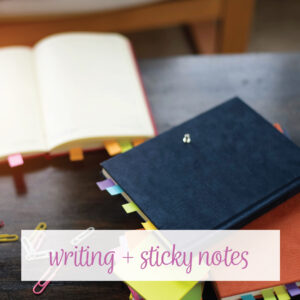
Station Two: writing.
Stack some note cards or sticky notes at this grammar station. Then, ask students to practice the grammar concept in their writing. For example, ask every group to write one simple sentence, one compound, one complex, and one compound-complex. You can use the sticky notes as additions to anchor charts. Use the note cards as exit tickets another day.
As a fun twist, you can provide directions such as, write two sentences with four power verbs on a piece of paper. Then, the next group must continue the story the first group started. (The stories are typically hilarious.) This group activity is the perfect way to practice punctuating dialogue.
Be sure to share the finished story with the class.
Station Three: young adult literature title search.
Stack piles of young adult literature and print out a one-pager for students to find adjectives. Then, ask students to create new titles using their adjectives.
Teachers have turned this into book spine creations and writing assignments. After students think of a new young adult title, ask them to write the first page of their new book. (You can keep their one-pagers and ask them to do the writing another day.)
Station Four: sentence structure manipulations.
Hands-on grammar might be the best grammar station! In my grammar manipulative bundle, I provide directions, but you can make your own directions too. Use grammar pieces to build sentences to focus on sentence structure.
You can also scaffold the lesson back and practice coordinating conjunctions, correlative conjunctions, and conjunctive adverbs. With hands-on grammar, all students can be successful.
This station is often hands-off for me. The only directions I include are for students to take pictures for me. This allows me to later see if I need to address misunderstandings. Most often though, I assemble the pictures in a basic Google presentation and use it to practice with students.
Station Five: build a word wall.
Whatever vocabulary you are studying, ask students to sort between adverbs, adjectives, and nouns to create an interactive word wall. Students can practice their part of speech with pictures, group writing, or individual sentences.
I typically print out our current vocabulary study for this station and ask students to complete two frames for our word wall. Then, I assemble the word wall and use it to review vocabulary. This practice makes for a nice integration of grammar to other parts of class.
Station Six: task cards.
Task cards were made for station work! I often ask students pass task cards amongst each other and forget how nicely they work with stations. Task cards already have directions, and I only include directions on the station dividers for how many task cards to complete.
Task cards do allow me to differentiate as well. You can set up different boxes of task cards and let students choose which ones they can handle. (I love that sort of data.)

Station Seven: action verbs.
Brainstorming and talking through action verbs is a fantastic way to connect grammar to vocabulary and then to student writing.
I typically pull verbs that are very common (too common!) in student writing. Then, I ask students to make a list or an anchor chart for new ways to word the common phrases. For instance, I’ll ask students to think of new action verbs for, “the author SAYS” or “the author WROTE.” This grammar station directly connects to student writing and builds community.
Station Eight: common grammar errors.
Grammar is SO much more than finding errors, but sometimes student writing shows us that we need to address grammar concerns. If you have troublesome areas, design a grammar station that addresses common errors.
Like so many of the other stations, the review of grammar errors is the perfect opportunity to reinforce that grammar is connected to other parts of class.
Station Nine: grammar sort.
Grammar sorts are simply grammar concepts in action on pieces of paper that students sort. For instance, students can sort active from passive voice, simple sentences from compound sentences, or verb moods. You can make these sorts a group effort and have students glue the pieces for a class poster, or you can have students sort them, snap a picture, and pile the pieces again, ready for the next group to sort.
Station Ten: color by grammar.
A color by grammar station typically has directions (I type the directions on the free dividers) for students to complete three or four coloring options. At the end of the class period, we have finished grammar sheets for decorations.
Coloring relaxes students, and this is frequently a favorite station.
Station Eleven: flash cards.
The flash card station is another station that is easy to differentiate, and not every student will complete this station. (You can also use a flash card station as part of any learning stations for middle school ELA.)
If students need basic review, ask them to create flash cards with definitions. If students are past that, ask them to think of rules. (I am flexible on the directions I provide for this station. Sometimes, I simply direct students to make grammar flash cards for what they know. I gather that data and build lessons from there.)
Still, if you want every student to complete every station, think of advanced tasks. Ask students to write a comma rule and think of an example. For instance, using commas in a series is a basic task, but using commas with coordinate adjectives is a more advanced task.
Then, the correct (I go through the flash cards!) flash cards become property of the class, and doing so honestly builds classroom community. Students will practice those flash cards, or I will set them out as we work on other projects. The creators always want recognition of their flash cards and will talk to their peers about using them.

Station Twelve: mentor sentences.
I print several short stories or nonfiction pieces we have covered as a class. To connect grammar to literature and articles, I highlight important sentences. Then, I ask questions on the station dividers. Students choose their sentences that I’ve highlighted and answer questions such as:
- What is the effect of passive voice?
- Did you notice a verb mood switch? What does that indicate?
- How did sentence structure provide transitions?
- Where did you see a “broken” grammar rule? Did you like that the author took this risk? Why?
Mentor sentences are typically a difficult grammar station, and some students might not work through it. I have asked students to repeat this station (once with fiction and once with nonfiction) while some students stay at a lower tiered station.
Station Thirteen: digital practice.
A digital activity works best if you are a 1:1 school, but you could maybe have this arranged on a classroom computer. Students complete an overall review in a Google Quiz. I like using these with grammar stations because I get a break with this station, as the results are automatically recorded. Plus, students get immediate feedback which they like.
Station Fourteen: basic identification.
Basic identification may be one of the scaffolded ends of grammar stations, and not everyone will travel to this station. I don’t label this station as the first station and then assign students that first station because the scaffolding will be incredibly obvious. When students struggle with a concept, I will ask them to practice with me at this station. For instance, students frequently struggle with comma use. A quick review with a helpful list can end confusion.
If students can identify grammar concepts, I move students to an analytical or application type grammar station.

Station Fifteen: video.
Videos can go several ways, but they are always interesting.
- Ask students to find a video to share with the class. (Students will probably find the conjunction song or a preposition dance.) Use those videos to recap the station work at the start of the next class period.
- If you are a 1:1 school, allow students to make a short clip of their explanation of a concept. You can assign concepts with a bulleted list on your grammar station dividers. Normally, I watch videos of my students acting out action verbs. Students have also pretended to be commas in sentences.
Grammar stations are versatile and easy to scaffold and differentiate. With a bit of creativity concerning directions, most grammar activities can work in a station rotation.
The benefits are huge! I can ask students to complete small sections and gauge where they are in their understanding. I can allow students to choose what they feel comfortable studying, which in turn provides me with important data. Most importantly, students enjoy grammar stations. They handle their language, they look at grammar in versatile ways, and they openly talk to me. The class periods with grammar stations are some of the best days in my classroom.
I imagine you’re reading this post because you enjoy stations with older students! Melissa at Reading and Writing Haven has more ideas for you. Check out Melissa’s approach to learning stations.
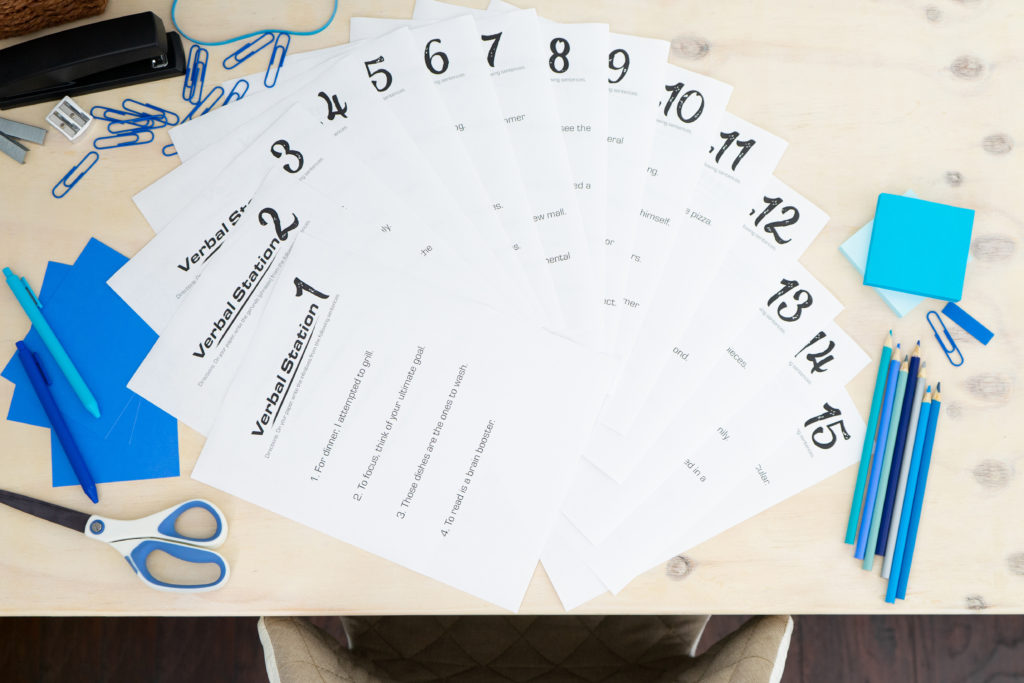
Are you interested in more grammar stations and learning stations for middle school ELA? Join Grammar Gurus for support and ideas.



